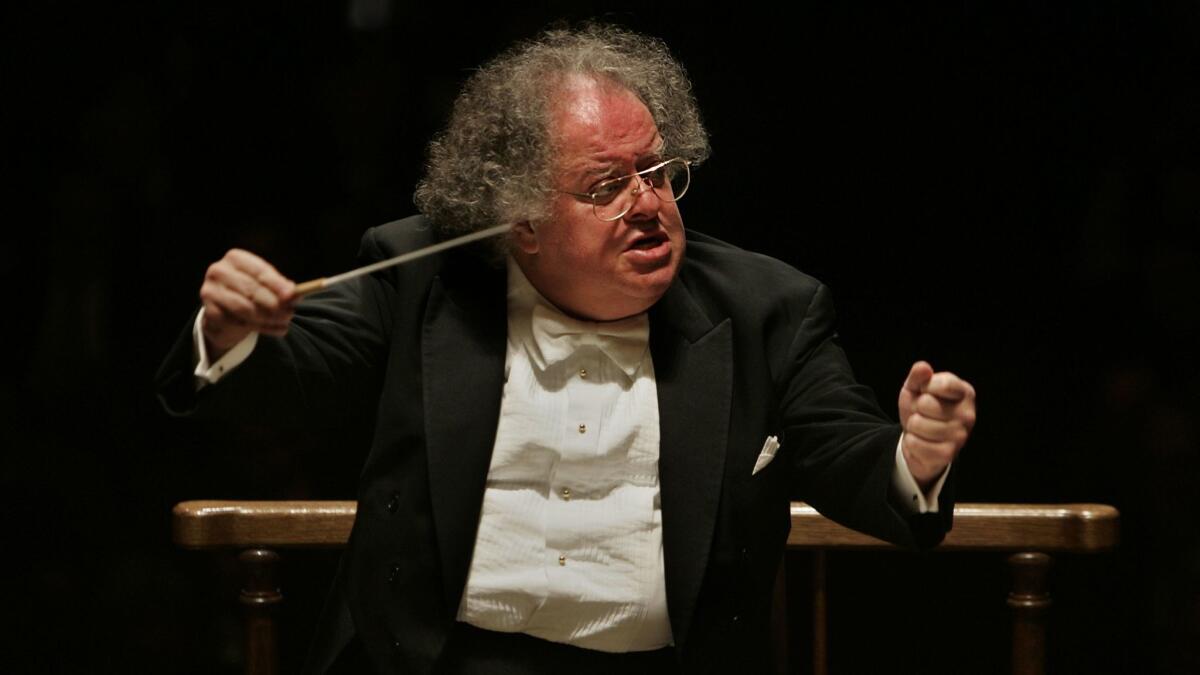Critic’s Notebook: On the Met’s James Levine, and the age-old debate of separating the art from the artist

James Levine has been a conductor in steady decline. Parkinsonian tremors along with several falls requiring surgery have severely reduced his mobility, and a cancerous kidney had to be removed. During the last decade he was forced to cancel numerous engagements and greatly reduce his once prodigious workload. Now at 74, he is confined to a wheelchair and conducts with shaking hands that make his beat hard to follow.
But through it all, he remained one of the most revered figures in classical music, celebrated for performances full of warmth and humanity. After four decades as music director of the Metropolitan Opera in New York, he was the Met until his frailty forced him to step down last season. He had been a great music director of the Chicago Symphony at its summer festival in Ravinia, a great music director of the Boston Symphony, a great music director of the Munich Philharmonic. He tirelessly mentored young singers, conductors and orchestral players who worshiped him like a god for his caring and devotion.
Then three weeks ago the Met said it would investigate allegations of sexual abuse leveled against Levine. Four men have stepped forward to accuse the conductor of abuse three or more decades ago when they were in their teens or 20s. Levine has denied the accusations, but the Met nonetheless suspended Levine’s future performances with the company. Ravinia, Boston and Munich followed suit by severing all ties with the conductor.
Between Thanksgiving and Christmas, Levine has gone from living legend to pariah. NPR has refused to broadcast his performances; movie theaters have canceled holiday screenings of the Met’s “Magic Flute” with Levine conducting. The age-old discussion of whether you can separate art from the artist has once more been ignited.
There is something deeply disturbing about all this. What I am about to say is going to be controversial, so let me make it clear from the start that if these allegations prove true, Levine will have caused indefensible harm.
But it is also painfully clear, in our current climate, that anyone once identified with Levine dare not presume him innocent until proven guilty.
Between Thanksgiving and Christmas, Levine has gone from living legend to pariah.
The Met is running so scared because Levine’s sexual behavior has been the subject of gossip for just about ever. I began hearing rumors from company members at the Met itself in the 1980s, when I lived in New York. Many at the company were unhappy about the rumors, but they loved Jimmy anyway.
He was maybe more secretive than most celebrated conductors about his personal life, but dark sides were all but expected in classical music and particularly the opera, where emotions necessarily runneth over. Moreover, most people who worked with Levine or who, like me, observed him from afar, saw mainly the good in him. We were in awe of the music making and, thus, the music maker.
But before everyone starts throwing stones, let me point out that we make peace with politicians, Wall Street and Silicon Valley. We convince ourselves that this is the way things must be because it is the culture, until we get a Weinsteinian shock.
To understand Levine, you have to go back to the summer of 1972. Artistically bankrupt and nearly so financially, the Met hired a visionary new director, a Swede, Goeran Gentele, who promised to revolutionize the conservative company with stagings by the likes of film director Ingmar Bergman and choreographer Jerome Robbins. For the first time, the Met hired a music director, noted Czech conductor Rafael Kubelik. Gentele’s most daring move of all was to make the 28-year-old Levine, who had only just made his Met debut, principal conductor.
Levine was obviously a musical genius. The accolades began as a child prodigy pianist. As a conductor, he apprenticed with the tyrannical George Szell at the Cleveland Orchestra. He was taken under the wing of the imperious king-maker, the artist manager Ronald Wilford. He moved in fast circles, like those of Leonard Bernstein’s. Coddled conductors could pretty much get away with murder.
It would not be unreasonable to assume that the young Levine lacked emotional maturity. The most successful musicians spend much of their lives alone practicing. They bask in praise. They attend conservatories, institutional hothouses where they hone their aggressively competitive skills to make it to the big time. They are pawns of the Wilfords, who look after careers, not lives.
Just as Gentele was preparing to open his first season, he died in an automobile accident. The panicked company failed to find a similar artistic visionary to head it. Without Gentele, Kubelik didn’t work out. Within three years Wilford had wormed Levine into the top spot.
The only real way we, as outsiders, have to trace Levine’s development is through his development at the Met, where he ultimately set the artistic policy. Musical standards at the company rose dramatically. Levine is rightfully praised for making a so-so Met orchestra into one of the world’s finest. He also saw to it that the chorus attained equally high standards. He nurtured singers galore. He made education a high priority.
Levine also brought the Met into the 20th century, greatly expanding the repertory. He favored American composers. He instituted the commissioning of new operas, something the company hadn’t done in a long time. I spent many an amazing night at the Met, when Levine had his way.
But at Levine’s Met, stagings stayed out of the music’s way. There was seldom theatrical or visual sophistication. The dramatic issues of opera, their real emotional meaning, were little explored, almost as if that were something to hide.
I don’t know Levine, but I have interviewed him and was startled in doing so. He typically came across as a schlumpy figure, plump, usually dressed in a polo shirt and carrying a brightly colored, oversized towel over his shoulder. His statements in public could be so pat that you might think him to be a corporate patsy. He carefully reveals little about himself in a 1998 book of dialogues with Robert C. Marsh.
But sit down and have a conversation with him and you would, in fact, find a sophisticated thinker about music, about the music world and about people. He searched works for their most telling meaning. He talked about other conductors with psychological insight. He turned out to be a seeker.
This might then leave us with the impression of Levine as overly cautious in some ways but in others, particularly when his conducting was unflinchingly introspective or orgiastic, altogether incautious. The least confrontational of conductors, Levine has always been a cajoler on the podium, but behind the scenes he is accused of the opposite.
That very intersection of good and bad, of course, is the territory of art. Anyone can come up with a list of great artists notable for displaying horrible traits. And, no, you cannot separate the maker from the final product. It is this very dealing with these issues, whether consciously or not, that produces meaningful results. Just as there can be no life without death, there can be no concept of good without bad.
Not coincidentally, opera is an art form that abounds in the value of forgiveness and the potential for redemption. It has the capacity for creating fascination that can lead to sympathy in characters who act appallingly (Salome calls for the head of John the Baptist, but it is her sexually harassing stepfather who is the more loathsome). In addition, opera is adept at depicting the terrors of mob mentality, warning about the dangers of revenge and extolling the healing value of clemency.
It would be far too simplistic to suggest that any of this reflects on the specifics of Levine’s situation. Rather, opera at its most profound becomes a spectacle of the inexplicable complexity of our emotions and our actions. Yet opera seems to be the last place where Levine and the Met have turned to come to terms with their own convoluted history.
This is its own kind of tragedy. The question is not whether the bad outweighs the good — our karma calculators are not powerful enough for that — but whether the bad destroys the good. Levine has left us with a lot that matters.
It just so happens that Mozart gives us detailed instructions — particularly in “The Marriage of Figaro,” “Così fan Tutte” and, his last and wisest opera, “La Clemenza di Tito” — for how to ask for and to give forgiveness, how to make amends, how to rise to an occasion in such a way to improve society. Some of Levine’s most persuasively illuminating performances happened to revolve around compassionately confronting the frailties, foibles and outright crimes of Mozart’s characters as they are coaxed into an examination of inner lives.
In Mozart – and in Levine’s best Mozart — clemency can lead to redemption. Is this just more mere “exotic and irrational entertainment,” as Samuel Johnson (who died in 1784, a year before Mozart began writing his mature operas) described opera? Or do we dare risk bringing the scales of justice into the opera house, with Mozart being the standard to which we are all asked to live up to?
More to Read
The biggest entertainment stories
Get our big stories about Hollywood, film, television, music, arts, culture and more right in your inbox as soon as they publish.
You may occasionally receive promotional content from the Los Angeles Times.











